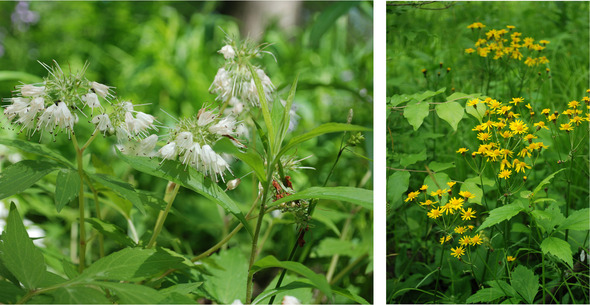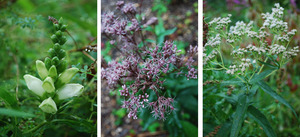Native plants often like wet places in your yard

Virginia Waterleaf (Hydrophyllum virginianum) and Golden Ragwort (Senecio aureus) are two native plants that would love being in your yard's wet spots.
Rick Meader | Contributor
Winter, or what we call winter around here, is great for revealing what you may have forgotten since the past growing season: spots in your yard that are often or usually wet. Many people curse them as "difficult places to mow" or "places only the dog/duck loves," but if you are one of those folks, you’re selling your yard short.
Those low places can become some of the showiest places you have if you will give up on trying to mow them and instead plant things there that actually like moister conditions. Many attractive native plants are extremely well-suited to sites with a good deal of moisture. So, as we start to look toward the spring and summer, let's think more broadly about our yards and where we might make some changes that will beautify them and save you some work in the long run.
First, you need to think back and consider the "moisture-enhanced" spots in your yard. Are they large or small? Are they mostly contiguous or are they islands unto themselves? How long do they stay wet — are they pretty much always wet, or do they just stay wet an annoyingly long time but dry out after a week or so? Are they sunny spots or shady spots?
These factors will all decide what you may want to do with them. (I'm assuming that you don't want to bring in earth-movers to re-contour your land in this exercise.)
Once you've done this inventory, you want to start thinking about how your yard could look instead of how it does look. For example, if your damp spot is in roughly the center of your yard, gets a lot of sun and is about 10 feet in diameter, you could very easily have a nice garden that supports three or more wildflowers that bloom in sequence through the growing season and stay put.
You could trade the brown and green quagmire that is a wet patch of lawn after being mown for yellow in the spring (Golden ragwort - Senecio aureus) or fall (Ohio goldenrod - Solidago ohioensis), pink in the summer (Swamp Milkweed - Asclepias incarnata and/or Marsh Blazingstar - Liatris spicata) and white in the summer (Mountain Mint - Pycnanthemum virginianum) or fall (Flat-topped Aster - Aster umbellatum or mountain mint).
You could put these in patches of five or six plants, or spread them around relatively randomly, but don’t just plant one of a species — allow for some cross-pollination and plant fatalities. In any case, these plants range in height from one to four feet, so they won’t be overpowering, but will attract your eyes and many butterflies to the formerly uninteresting spot in your yard.
The more, or bigger of these spots you have, the more color in the forms of flowers and flying insects you will add to your yard. Meanwhile, you’ll also be alleviating the stress of getting your mower stuck in your yard.

Blue Lobelia (Lobelia siphilitica), Flat-topped Aster (Aster umbellatus), Maidenhair Fern (Adiantum pedatum) and Swamp Milkweed (Asclepias incarnata) are all plants that would love to take the place of wet sod
Rick Meader | Contributor
If your spot doesn't get a lot of sun, ferns or showy sedges might be in order. Most ferns don’t like sun, but they do like moisture, so a damp spot could be just the thing for them.
Among the locally commercially available ferns are Maidenhair fern (Adiantum pedatum), Lady fern (Athyrium filix-femina), Bulblet fern (Cystopteris bulbifera), Royal fern (Osmunda regalis), Ostrich fern (Matteuccia struthiopteris) and Marginal wood fern (Dryopteris marginalis). Most of these range in height between one and three feet, but the Royal fern can reach five feet. Also, some, like the Ostrich fern, can spread a lot, so do some research before selecting any.
Sedges like Gray’s sedge (Carex grayii), Fringed sedge (Carex crinita) and Hop Sedge (Carex lupulina) have interesting seed heads to add some variety to the look of your clammy spot in addition to the rich green cover they provide.
Most flowering plants like at least some sun, so if your wet spot gets only partial shade, Cardinal Flower (Lobelia cardinalis), Blue Lobelia (Lobelia siphilitica), Woodland Phlox (Phlox divaricata), Virginia Waterleaf (Hydrophyllum virginianum), Turtlehead (Chelone glabra), Joe Pye-Weed (Eupatorium maculatum) or Boneset (Eupatorium perfoliatum) can brighten up your spot.

Turtlehead (Chelone glabra), Joe Pye-Weed (Eupatorium maculatum) and Boneset (Eupatorium perfoliatum) can often be found in swampy areas, so your wet lawn would suit them just fine
Rick Meader | Contributor
If you have a lot of wet area, you may be able to have both a sunnier area and a shadier area, providing conditions for all of the plants mentioned above.
As you can see, you have a lot of options when you have a chronically over-watered area in your lawn beyond cursing it. You can make it a colorful haven for your eyes, butterflies, bees and maybe even a hummingbird or songbird feeding on the plants' leaves, nectar or seeds. And, you don't have to water the area to get these effects.
Just choose the right native plants, prep the area correctly (you might want to smother the grass with newspaper and mulch to kill off the lawn grasses you’re trying to replace) and prepare for a growing season of color and satisfaction in your quagmire.
Rick is a local landscape architect with a special interest in all things natural, including creating designs that include a lot of native plants (and the critters they support). You can contact him at yourland1824@gmail.com.


Comments
RunsWithScissors
Tue, Mar 13, 2012 : 12:38 p.m.
This is excellent information. I hope to see a similar article for sun-lovin' plants in dry places. The south side of my house tends to be a lot warmer and dryer than elsewhere in the garden. I haven't had much luck - even with native plants - in getting something to take root there.